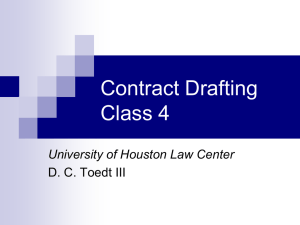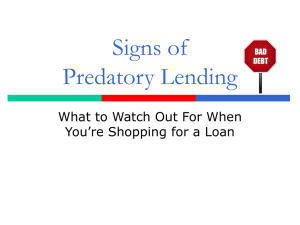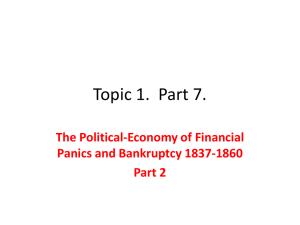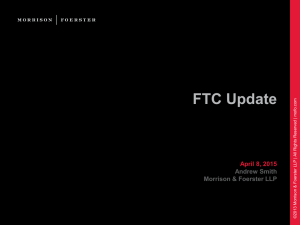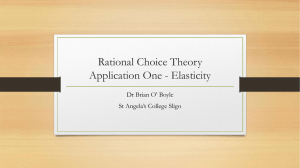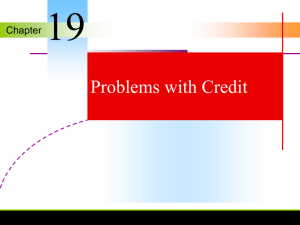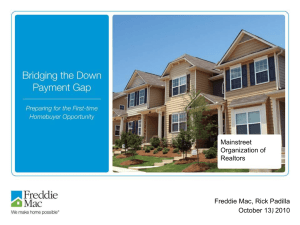The Myth of the Rational Borrower: Rationality, Behavioralism and
advertisement
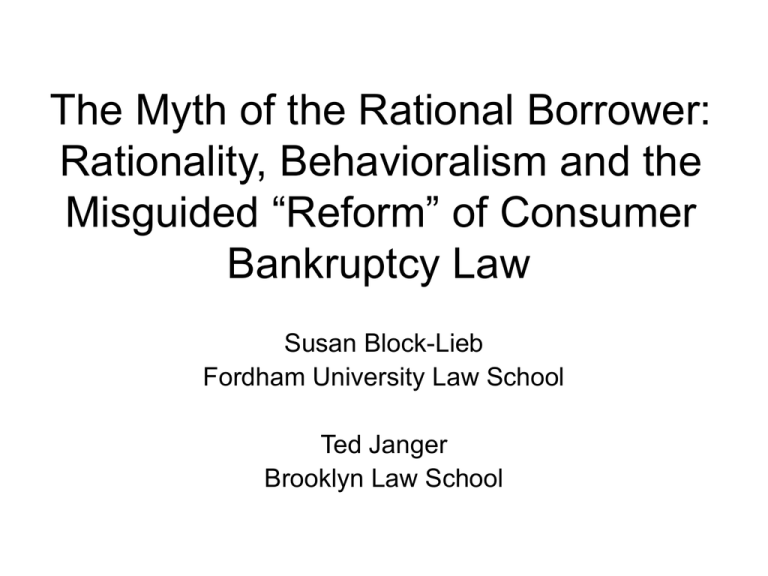
The Myth of the Rational Borrower: Rationality, Behavioralism and the Misguided “Reform” of Consumer Bankruptcy Law Susan Block-Lieb Fordham University Law School Ted Janger Brooklyn Law School U.S. Bankruptcy Policy Debate Lender R,R R,I Borrower I,R I,I • Policy prescriptions turns on why people break their promises: – whether the lender or borrower are viewed as opportunistic or unfortunate? • Paradigmatic Borrower/Bankrupt – Rational/irrational? • Paradigmatic Lender – Rational/irrational? Worldview Motivating “Bankruptcy Reform” – Rational/Rational • Assumptions: – Rational Consumers • Rational and/or strategic actors • Bankruptcy discharge gives consumers a “free walk” on their consumer debt • Consumers who don’t file for bankruptcy will repay their debts in full – Rational (but impaired) Lenders • Cannot price discriminate – Cannot determine borrower’s type (honest/dishonest) – Increases in the cost of credit lead to adverse selection » High risk borrowers are price inelastic » Low risk borrowers are price elastic • Even in a competitive market, credit will be rationed – All consumers will pay a higher interest rate and borrow less than is “efficient.” – Deadweight loss results Policy Prescription – Eliminate Bankruptcy Discharge • Limiting access to bankruptcy discharge will result in greater supply and lower cost of credit. Some data supports the “rational borrower/rational lender” view: Non-Business Bankruptcy Filings: 1970-2003 1,800,000 1,600,000 1,400,000 1,200,000 1,000,000 NBusBank 800,000 600,000 400,000 200,000 2004 2003 2002 2001 2000 1999 1998 1997 1996 1995 1994 1993 1992 1991 1990 1989 1988 1987 1986 1985 1984 1983 1982 1981 1980 1979 1978 1977 1976 1975 1974 1973 1972 1971 1970 0 Household Debt Has Increased In Absolute terms Debt per Household in 1975 Dollars 25,000 20,000 15,000 Series1 10,000 5,000 0 75 19 77 19 79 19 81 19 83 19 85 19 87 19 89 19 91 19 93 19 95 19 97 19 99 19 01 20 03 20 And In Relation to Disposable Income But other data suggest that lenders do not think that borrowers are opportunistic Interest Rates Have Gone Down in Absolute Terms Commercial Bank Consumer Installment Credit Finance Rates: 1975-2003 20 18 16 14 12 New Car 10 OtherCG CCPlans 8 6 4 2 0 1975 1976 1977 1978 1979 1980 1981 1982 1983 1984 1985 1986 1987 1988 1989 1990 1991 1992 1993 1994 1995 1996 1997 1998 1999 2000 2001 2002 2003 Moreover, the relation between market interest rates and credit card interest rates has remained roughly constant. Credit Card-TBill Spread 1983-2003 16 14 10 CCMarkUp Linear (CCMarkUp) 8 6 4 2 Year 20 03 20 02 20 01 20 00 19 99 19 98 19 97 19 96 19 95 19 94 19 93 19 92 19 91 19 90 19 89 19 88 19 87 19 86 19 85 19 84 0 19 83 Interest Rate Spread 12 Paradox • Even though bankruptcy filings have increased considerably over time – And in good times as well as bad • The supply of consumer credit has increased unabated. • The interest rate paid on consumer debt has declined while the markup (risk premium) has remained constant. And credit card lending remains very profitable Theory predicts credit rationing and increasing interest rate • Data raise questions – Why would lenders ever agree to lend to opportunistic borrowers?? • Data fit better with a different story, which takes into account developments in the consumer credit market and in consumer lending technology . . . U.S. Credit Markets in 1978 • Usury limits • Inability to price risk – Limited access to credit information – Local transactions/local reputation U.S. Market changes beginning in 1978 – Usury • Marquette • Usury limits eliminated in national lending transactions – National lending suddenly became more profitable than local lending – But only if you could get over the information asymmetry. U.S. Changes in the mid-1980s – Information Asymmetry • National credit reporting – Credit scoring – Risk based pricing • National lending technologies – Securitization – National clearinghouses (Visa/Mastercard) Worldview Motivating “Bankruptcy Reform” – Redux • Assumptions: – Consumers • Rational and/or strategic actors • Bankruptcy discharge gives consumers a “free walk” on their consumer debt • Consumers who don’t file for bankruptcy will repay their debts in full – Lenders • Cannot price discriminate Yes they can – Cannot determine borrower’s type (honest/dishonest) – Increases in the cost of credit lead to adverse selection » High risk borrowers are price inelastic » Low risk borrowers are price elastic • Even in a competitive market, credit will be rationed Not necessarily – All consumers will pay a higher interest rate and borrow less than is “efficient.” – Deadweight loss results Implications for lenders • Enables lenders to market credit to higher risk borrowers without fear of adverse selection • Lending can be profitable even with higher default rates • And higher bankruptcy filing rates Now profitability and high default rates are not mutually contradictory Is this a problem? • That depends on your view of the borrower? – Rational – Only “quasi-rational.” What are the implications of a behavioral model of the market for consumer finance? For rational lenders and quasi-rational consumer borrowers Behavioral decision research suggests that consumers will purchase and borrow more than rational actors. It also suggests that consumer borrowers will be slow to react to forestall default and that rational lenders face market incentives to exploit borrowers’ decisional biases. Rational v. Quasi-Rational Purchasing: • Rational consumers possess: – Complete information – Stable preferences • Quasi-rational consumers possess: – Bounded rationality – Preferences influenced by biases in decisionmaking such as framing and anchoring effects Rational vs. Quasi-Rational Borrowing: • (i) What are the costs and benefits of filing for bankruptcy? • (ii) How much do I owe already? • (iii) What is the cost of the new credit transaction? • (iv) What is the likelihood that my income will either remain constant or increase in the next period? • (v) Which is stronger, my preference for current consumption or my preference for consumption in the future? How much do I owe already? • A rational borrower: – Complete information – Computational facility • A quasi-rational borrower: – Credit card users spend more than those spending cash or writing checks. Why? • Cognitive dissonance • Underestimation of ability to repay at months’ end • Underestimation of total purchases within past month • Decision framed by credit limits as signal of future earnings potential What is the cost of the new credit transaction? • A rational borrower: – Complete information – Computational facility • A quasi-rational borrower: – Confusing array of financial products offered at complex terms – Financial illiteracy; time constrained – Rule of thumb what is the cost of the monthly payment? – Does disclosure regulation help? What is the likelihood that my income will either remain constant or increase in the next period? • A rational borrower: – Complete information – Computational facility • A quasi-rational borrower: – Ambiguity in decisionmaking – Overconfidence bias Which is stronger, my preference for current consumption or my preference for consumption in the future? • A rational borrower: – Complete information – Stable preferences – Ability to delay gratification – Applies a single discount rate over time • A quasi-rational borrower: – Framing and other influences on preferences – Immediate gratification – Hyperbolic discounting What should I do in the event of default? • A rational borrower: – Complete information – Framing of events irrelevant – Willingness to walk away from investments, if marginal costs exceed marginal benefits – Willingness to sell = willingness to buy • A quasi-rational borrower: – Prospect theory – Sunk investments – Endowment effects Research agenda: • Behavioral decision research suggests that: – Consumers will borrow more than a rational actor model predicts, but there has been no testing of this hypothesis. – Consumers will be slow to react to signs of default, and more reluctant to liquidate possessions than RAM predicts, but there have been few studies. – Rational lenders face market incentives to exploit quasi-rational consumers’ decisional biases. Policy implications: • Consumer bankruptcy law; consumer finance regulations • Because rational lenders face incentives to exploit biases in decisionmaking, consumer protection regulations should invalidate or otherwise limit certain Ks or K terms • Disclosure regulation may be insufficient consumer protection, standing alone – Framing affects disclosure – Lenders’ incentives to craft terms to evade disclosure requirements • Financial literacy education; budget and credit counseling

